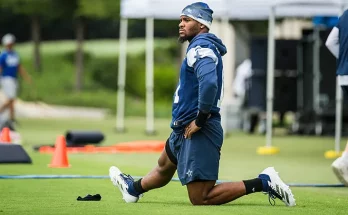Notre Dame’s football program has long carried the weight of history and expectation, boasting one of the most storied legacies in college football. From Knute Rockne’s revolutionary coaching in the 1920s to the national championships of the 1940s and beyond, the Fighting Irish have consistently been a fixture in discussions of elite collegiate programs. However, in recent years, Notre Dame has had to adapt to a rapidly evolving college football landscape, one defined by transfer portals, NIL (Name, Image, and Likeness) deals, early NFL departures, and a playoff system that favors flexibility and depth. Yet, through a combination of strategic recruiting, tactical innovation, and institutional stability, Notre Dame has positioned itself as a more durable national title contender for this new era of college football.
A major factor in Notre Dame’s renewed resilience has been its ability to recruit top-tier talent consistently. Historically, the program relied heavily on its storied tradition and national brand to attract elite players, but modern college football demands a more nuanced approach. Notre Dame has embraced this reality by expanding its recruiting footprint nationally, particularly focusing on talent-rich regions beyond its traditional Midwest stronghold. By securing commitments from elite athletes in California, Texas, Florida, and Georgia, the Fighting Irish have diversified their roster with players who bring both skill and versatility. This expansion has allowed Notre Dame to field teams with greater depth, mitigating the impact of injuries and attrition that can derail championship aspirations.
Another critical aspect of Notre Dame’s resurgence is the program’s adaptability in its coaching philosophy. The modern game emphasizes speed, flexibility, and innovative schemes that can adjust on the fly to opponents’ strategies. Under its current coaching leadership, Notre Dame has demonstrated a willingness to blend traditional football principles with contemporary innovations. The offensive schemes, for instance, have become more dynamic, incorporating spread concepts, RPOs (run-pass options), and multi-dimensional quarterback play. On defense, the team has adopted more hybrid packages, allowing players to shift seamlessly between coverage and pass rush roles, which keeps opponents off balance. This willingness to innovate tactically has made Notre Dame less predictable and more capable of sustaining success against a variety of opponents.
Player development has also played a significant role in Notre Dame’s durability as a contender. While recruiting is essential, the program’s ability to take highly touted high school prospects and elevate them into elite collegiate performers has been impressive. Notre Dame’s strength and conditioning programs, combined with its coaching staff’s emphasis on fundamentals and situational football, have created a pipeline of athletes who can excel in high-pressure environments. This development extends to quarterbacks, a position historically critical to national championship runs, where the program has consistently produced players capable of managing complex offenses and making decisive plays in pivotal moments. The result is a roster that is not only talented but also prepared mentally and physically to compete at the highest level throughout the season.
The cultural stability and institutional support at Notre Dame have further contributed to its standing as a national contender. Unlike many programs that experience frequent coaching turnover or administrative instability, Notre Dame benefits from a consistent philosophy and strong leadership at the university level. This stability fosters an environment where players and coaches can focus on development and competition without the distraction of uncertainty. Additionally, Notre Dame’s independent status in football allows it to craft a schedule that balances tradition, competitiveness, and exposure, ensuring that the team faces a variety of challenges while remaining in contention for playoff consideration. This strategic scheduling, coupled with the program’s national visibility, ensures that Notre Dame remains relevant in conversations around elite college football programs.
The advent of the College Football Playoff (CFP) era has also necessitated a shift in Notre Dame’s approach. The playoff system rewards teams that not only win consistently but also demonstrate the ability to compete against high-caliber opponents late in the season. Notre Dame has responded by emphasizing depth and versatility across its roster, ensuring that injuries or unexpected setbacks do not derail its championship pursuits. The team’s approach to in-season adjustments and mid-season evaluations reflects a modern understanding of sustaining performance over a grueling schedule. Moreover, the coaching staff places a premium on mental toughness and situational awareness, recognizing that the playoff era demands excellence under pressure. By fostering a culture of accountability and resilience, Notre Dame has cultivated a team identity that thrives in high-stakes scenarios.
Notre Dame’s engagement with the NIL era has also strengthened its national title prospects. In a time when elite players are increasingly influenced by opportunities for personal brand growth, the Fighting Irish have leveraged their national reputation and media exposure to create appealing pathways for athletes. Notre Dame provides access to one of the most recognized brands in college sports, combined with a platform for endorsement deals and exposure that few other programs can match. This strategic positioning has allowed the program to attract and retain talent who might otherwise be swayed by programs with more direct conference revenue streams or high-profile media markets. By successfully navigating the NIL landscape, Notre Dame has ensured that it remains competitive in recruiting battles while maintaining roster cohesion and morale.
The Fighting Irish have also demonstrated adaptability in embracing the transfer portal, a transformative element of modern college football. The portal allows programs to quickly fill gaps and enhance depth by acquiring experienced players from other programs. Notre Dame has strategically utilized this resource to bolster its roster, particularly in positions of need, without compromising the development of homegrown talent. This approach provides a balance between immediate competitiveness and long-term sustainability, ensuring that the team is consistently well-positioned to compete for national championships. The integration of transfer players into Notre Dame’s culture, combined with a disciplined approach to team cohesion, has made the roster more resilient and versatile than in past eras.
Another dimension of Notre Dame’s evolution as a national contender is its commitment to analytics and sports science. The program has invested in advanced metrics to optimize performance, evaluate opponents, and inform strategic decisions. This data-driven approach complements traditional coaching instincts, allowing the team to make more informed choices in game preparation and player utilization. From monitoring player workloads to analyzing tendencies of opposing defenses, Notre Dame’s embrace of technology reflects a modern mindset that prioritizes efficiency and precision. These innovations have provided the team with a competitive edge, particularly in tight games where marginal gains can determine outcomes.
Historically, Notre Dame has faced challenges in sustaining national prominence due to the cyclical nature of college football and the pressures of maintaining a broad recruiting reach as an independent program. However, the strategic initiatives implemented over recent years have transformed the program into a more durable contender. By combining elite recruiting, innovative coaching, robust player development, institutional stability, savvy use of the transfer portal, NIL engagement, and analytics, Notre Dame has crafted a framework capable of enduring the complexities of modern college football. Unlike teams that rise and fall based on single recruiting classes or coaching changes, Notre Dame has built resilience into its program, ensuring that it remains in contention year after year.
This durability is evident in the team’s recent performances and postseason positioning. Notre Dame has consistently demonstrated the ability to compete against top-tier programs, both within its independent schedule and in marquee bowl games. The team’s resilience in close contests, coupled with its capacity to reload talent continuously, has set it apart from programs that rely solely on transient peaks of talent or favorable scheduling. Furthermore, Notre Dame’s brand and tradition continue to provide a psychological advantage, attracting recruits, fans, and media attention that amplify its national profile. This combination of tangible resources, strategic foresight, and cultural legacy has positioned Notre Dame to compete not only for conference-level accolades but also for national championships with a consistency that has been increasingly rare in the modern era.
Notre Dame’s trajectory suggests that the program has not merely adapted to the new era of college football but has strategically leveraged its strengths to become more sustainable as a national title contender. The Fighting Irish understand that modern championship pursuits require depth, versatility, innovation, and strategic engagement with the broader collegiate sports ecosystem. By aligning its historical brand with contemporary operational strategies, Notre Dame has created a football program capable of navigating the complexities of the 21st-century college game. The blend of tradition and forward-thinking practice, combined with a commitment to developing resilient and versatile athletes, underscores why Notre Dame is now viewed not merely as a historic power but as a consistently viable contender on the national stage.
In conclusion, Notre Dame’s evolution into a more durable national title contender reflects a deliberate and multifaceted approach to modern college football. Through strategic recruiting, innovative coaching, comprehensive player development, cultural stability, astute use of the transfer portal, engagement with NIL opportunities, and reliance on analytics, the Fighting Irish have fortified their program against the volatility of the contemporary game. This durability is not simply about winning isolated seasons but about creating a sustainable framework that positions Notre Dame to compete at the highest level year after year. As college football continues to evolve, Notre Dame’s blend of historical prestige and modern adaptability ensures that it remains a formidable force, capable of sustaining success in an era defined by rapid change and heightened competition.



